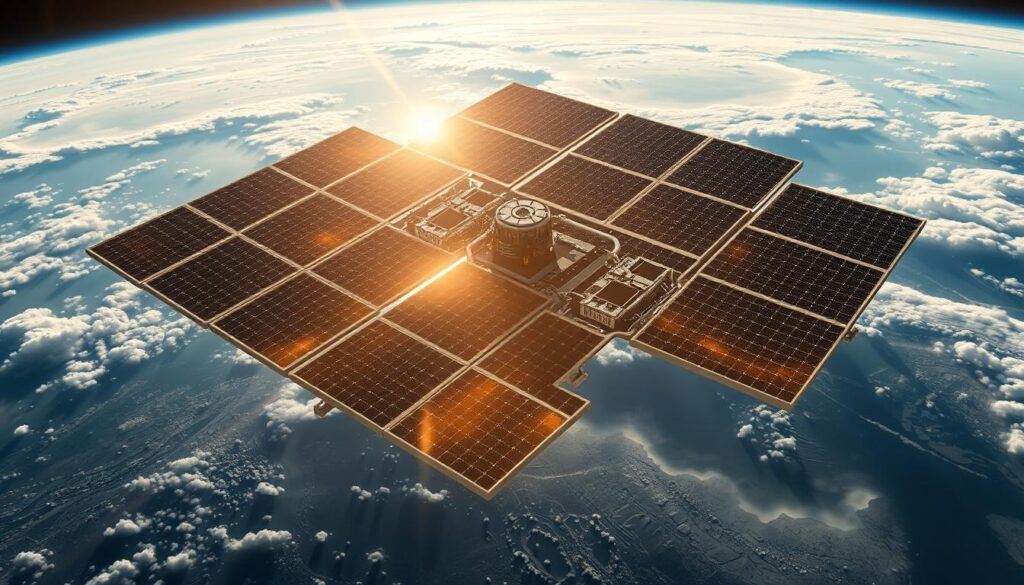The European Space Agency (ESA) is exploring space-based solar power as a potential contributor to Europe’s Net Zero carbon emissions goal by 2050. This initiative highlights the growing interest in renewable energy sources and sustainable development.
Space-based solar energy involves harnessing solar power in orbit and beaming it back to Earth. Germany, being a key player in the European energy landscape, is likely to benefit from this technology.
Key Takeaways
- The ESA is exploring space-based solar power to achieve Net Zero carbon emissions by 2050.
- This technology involves harnessing solar power in orbit and beaming it back to Earth.
- Germany is poised to benefit from this innovative renewable energy source.
- Space-based solar energy could contribute significantly to Europe’s sustainable development.
- The potential benefits of this technology are being closely monitored by energy experts.
Introduction to Space-Based Solar Energy Transfer
As the world seeks cleaner energy alternatives, space-based solar energy emerges as a promising solution. The idea of harnessing solar energy from space is not new, but recent advancements in space technology have made it a more viable option for renewable energy generation.
Solar energy generation has grown cheaper and more efficient over the years. However, it still faces fundamental limitations such as dependence on daylight and weather conditions. Space-based solar energy offers a potential solution to these challenges by capturing solar energy in orbit around the Earth, where sunlight is available 24/7.
What is Space-Based Solar Energy?
Space-based solar energy involves collecting solar radiation in orbit around the Earth and beaming it back as a usable form of energy, typically microwaves. This energy is then converted into electricity on the ground. The concept leverages the constant availability of sunlight in space to provide a steady supply of energy.
Importance of Solar Energy in Germany
Germany has been a pioneer in adopting renewable energy sources, with a significant focus on solar energy. The country’s commitment to reducing carbon emissions and transitioning to a more sustainable energy mix makes space-based solar energy an attractive option.
The potential benefits of space-based solar energy for Germany include:
- Enhanced energy security through a diverse energy mix.
- Reduced greenhouse gas emissions.
- Creation of new technological and industrial opportunities.
| Benefits | Description |
|---|---|
| Energy Security | Diverse energy mix reduces dependence on fossil fuels. |
| Environmental Impact | Reduced greenhouse gas emissions contribute to a cleaner environment. |
| Economic Opportunities | New industries and job opportunities emerge from space-based solar technology. |
By exploring space-based solar energy, Germany can further its goals in renewable energy and lead the way in innovative space technology applications.
Overview of Current Solar Energy Technologies
Ground-based solar systems are the backbone of Germany’s current solar energy infrastructure. These systems have been instrumental in helping Germany achieve its renewable energy targets. However, as the country continues to expand its sustainable energy capacity, it’s essential to examine the current technologies and their limitations.
Ground-Based Solar Systems
Ground-based solar systems involve the installation of solar panels on land to generate electricity. These systems are widely used due to their relatively low cost and established infrastructure. The benefits of ground-based solar systems include:
- Established technology with a proven track record
- Lower upfront costs compared to other forms of solar energy generation
- Ease of maintenance and repair
Despite these advantages, ground-based solar systems face several challenges. For instance, they are heavily dependent on weather conditions, with their efficiency reduced on cloudy days. Moreover, the land required for large-scale solar farms can lead to conflicts over land use, particularly in densely populated areas like Germany.
Limitations of Conventional Solar Energy
The limitations of conventional solar energy are multifaceted. Intermittency is a significant issue, as solar energy generation is not constant and varies with daylight hours and weather conditions. Additionally, the requirement for large areas of land can lead to environmental concerns, such as habitat destruction and water usage for cleaning panels.
Some of the key limitations include:
- Intermittency of energy supply
- Land use requirements and associated environmental impacts
- Vulnerability to weather conditions
As Germany looks to further expand its solar power capacity, addressing these limitations will be crucial. One potential solution is space-based solar energy, which offers a constant and reliable source of renewable energy. By exploring such innovative technologies, Germany can continue to lead in the transition to a more sustainable energy future.
“The future of solar energy lies not just in improving existing technologies but in exploring new frontiers like space-based solar power.”
The Concept of Space-Based Solar Energy
The concept of space-based solar energy involves capturing solar radiation in space and beaming it back to Earth as a clean source of power. This innovative approach to renewable energy has garnered significant attention due to its potential to provide a constant and reliable source of energy.
Definition and Functionality
Space-based solar energy systems are designed to collect solar power in orbit around the Earth and transmit it back to the planet. This is typically achieved through satellites equipped with solar panels that convert sunlight into energy, which is then converted into microwaves or lasers for transmission back to Earth.
The functionality of these systems relies on several key components:
- Solar panels or collectors to gather solar energy in orbit.
- Power conversion systems to transform the collected energy into a transmissible form.
- Transmission technology, such as microwaves or lasers, to send the energy back to Earth.
- Receiving stations on Earth to capture the transmitted energy and convert it into usable electricity.
The advantages of space-based solar energy include its ability to provide energy continuously, unaffected by day-night cycles or weather conditions. This makes it a potentially reliable source of renewable energy.

Historical Background of Space-Based Solar Energy
The idea of space-based solar energy was first proposed in the 1960s by Dr. Peter Glaser, an American engineer. Since then, various countries have explored this concept through research and development programs.
The historical development of space-based solar energy has been marked by advancements in satellite technology, power transmission, and solar panel efficiency. Despite the challenges, the concept remains a promising avenue for future renewable energy.
Key milestones in the development of space-based solar energy include:
- Initial conceptualization and proposal by Dr. Peter Glaser in the 1960s.
- Early-stage research and development in the 1970s and 1980s, primarily in the United States and Japan.
- Recent advancements in technology and renewed interest in space-based solar energy as a viable renewable energy source.
Germany’s Investment in Space Technology
Germany is making significant strides in space technology, particularly in the realm of space-based solar energy. This investment is a testament to the country’s commitment to renewable energy and its willingness to explore innovative solutions. As a result, Germany is positioning itself at the forefront of the space-based solar energy industry.
Government Initiatives and Funding
The German government has launched several initiatives to support the development of space-based solar energy. One notable example is the funding allocated through the European Space Agency (ESA), which has enabled German companies and research institutions to participate in key projects. According to Dr. Walther Pelzer, Deputy Director-General of the German Aerospace Center (DLR), “The investment in space-based solar energy is a strategic move to secure Germany’s energy future.”
A significant portion of the government’s funding is directed towards research and development programs focused on overcoming the technical challenges associated with space-based solar energy. This includes advancements in photovoltaic technology, energy storage, and transmission systems. By supporting these initiatives, the German government is fostering a collaborative environment that encourages innovation and accelerates the development of space-based solar energy.
Partnerships with Private Enterprises
In addition to government initiatives, partnerships with private enterprises play a crucial role in driving Germany’s investment in space technology. Companies such as OHB SE and Astrium GmbH are working closely with research institutions and government agencies to develop cutting-edge space-based solar energy solutions. These collaborations are essential for leveraging the expertise and resources needed to bring this technology to fruition.
As
“The future of energy lies in space, and Germany is committed to being a leader in this field,”
stated by
, highlighting the country’s ambitious goals in space-based solar energy. The synergy between government support and private sector innovation is expected to propel Germany’s space technology sector forward, making significant contributions to the global renewable energy landscape.
The Role of the German Aerospace Center (DLR)
The DLR is instrumental in shaping the future of space-based solar energy in Germany. As a leading research institution, it drives innovation in this field through various research and development programs.
Research and Development Programs
The DLR’s research and development programs are focused on overcoming the technical challenges associated with space-based solar energy. These programs involve advanced research in solar panels, energy storage, and transmission technologies. The center collaborates with industry partners to develop practical solutions for deploying space-based solar energy systems.
A key area of research is the development of more efficient solar panels that can withstand the harsh conditions of space. The DLR is also exploring innovative materials and designs to improve the durability and performance of these panels.
Collaborations with International Space Agencies
The DLR collaborates with international space agencies to leverage global expertise and resources. These collaborations facilitate the sharing of knowledge, technologies, and best practices in space-based solar energy. The DLR works closely with agencies such as NASA and the European Space Agency (ESA) on joint research projects and initiatives.
One notable collaboration is the DLR’s participation in the ESA’s Space Situational Awareness (SSA) program, which includes research on space-based solar energy. This partnership enables the DLR to contribute to and benefit from international efforts in advancing this technology.
| Program | Description | Partners |
|---|---|---|
| Solar Panel Efficiency | Research on improving solar panel efficiency for space applications | NASA, ESA |
| Energy Storage Systems | Development of advanced energy storage systems for space-based solar energy | Industry Partners, University of Stuttgart |
| Transmission Technologies | Innovative technologies for transmitting energy from space to Earth | DLR, ESA, Private Enterprises |
Potential Benefits of Space-Based Solar Energy
The potential benefits of space-based solar energy are multifaceted, offering a cleaner, more sustainable energy solution. By harnessing solar energy in space, Germany can significantly reduce its reliance on fossil fuels, thereby mitigating climate change.
Environmental Impact
Space-based solar energy has the potential to provide a constant and clean source of energy. This technology can help reduce greenhouse gas emissions, contributing to a cleaner environment. The environmental benefits are substantial, as it eliminates the need for large land areas required by traditional solar farms, thus preserving natural habitats.
Key environmental advantages include:
- Reduced greenhouse gas emissions
- Minimal land use requirements
- Constant energy supply, unaffected by weather conditions

Economic Advantages for Germany
The economic benefits of adopting space-based solar energy in Germany are considerable. This technology can create new job opportunities in the renewable energy sector, stimulate local economies, and reduce energy costs in the long term. Moreover, being at the forefront of this technology can position Germany as a leader in the global renewable energy market.
Economic advantages include:
- Job creation in the renewable energy sector
- Potential for reduced energy costs
- Leadership in the global renewable energy market
By embracing space-based solar energy, Germany can make significant strides towards achieving its renewable energy goals while contributing to a more sustainable future.
Technical Challenges of Space-Based Solar Energy Systems
The technical challenges of space-based solar energy systems are multifaceted, involving both launch and energy transmission complexities. As Germany continues to invest in space technology, addressing these challenges is crucial for the successful implementation of space-based solar energy transfer systems.
Launch and Deployment Challenges
Launching and deploying large structures in space is a significant technical challenge. The massive size and weight of solar panels and satellites require advanced launch vehicles with substantial payload capacities. Moreover, the deployment process in orbit must be highly precise to ensure the structural integrity and functionality of the solar panels.
Several key issues are associated with launch and deployment:
- The need for heavy-lift launch vehicles capable of carrying large payloads to geostationary orbit.
- The complexity of deploying large, lightweight structures in space without damaging them.
- The requirement for precise orbital positioning to ensure optimal solar energy collection and transmission.
Energy Transmission Technologies
Efficiently transmitting energy from space to Earth is another critical challenge. The technology involves converting solar energy into a form that can be transmitted over long distances with minimal loss. Currently, microwave energy transmission and laser-based systems are being explored.
Key considerations for energy transmission include:
- Developing high-efficiency converters to transform solar energy into microwaves or laser beams.
- Ensuring the safety and minimizing the environmental impact of energy transmission.
- Achieving high accuracy in directing the energy beam towards the receiving station on Earth.
As Dr. Johann-Dietrich Wörner, former Director General of the European Space Agency, once noted, “The challenge is not just about collecting solar energy in space, but also about transmitting it back to Earth efficiently and safely.”
Case Studies: Global Examples of Space-Based Solar Projects
Nations are turning their attention to space-based solar energy as a potential game-changer in the renewable energy sector. This shift is driven by the need for sustainable and constant power sources, which space-based solar energy can provide due to its ability to harness solar energy in orbit around the Earth, unaffected by day-night cycles or weather conditions.
Japan’s Space Solar Power Program
Japan has been at the forefront of space-based solar energy research and development. The Japan Aerospace Exploration Agency (JAXA) has been actively involved in promoting space solar power systems. One of the significant initiatives includes the development of a commercial space solar power system by the year 2040. This involves the use of advanced technologies such as high-efficiency solar cells and wireless power transmission.
Key Achievements: JAXA has successfully demonstrated wireless power transmission in space, a crucial technology for space-based solar power. They have also conducted ground-based experiments to validate the feasibility of space solar power systems.
The United States’ Initiatives in Space-Based Solar
The United States has also been actively exploring space-based solar energy through various government and private initiatives. The NASA Solar Power Investigation is one such effort that aims to assess the feasibility of space-based solar power. Private companies like Mankind and Space Systems/Loral are also working on related projects, focusing on the development of necessary technologies and infrastructure.
Notable Developments: The U.S. Department of Energy has funded several studies on space solar power, examining its potential as a future energy source. These studies have highlighted the potential benefits, including the constant availability of solar energy in space and the potential for beaming power back to Earth.
The global initiatives in space-based solar energy underscore the growing interest in this technology as a viable source of renewable energy. As research and development continue, countries like Japan and the United States are paving the way for potential future implementations of space-based solar energy systems.
German Public Perception of Space-Based Solar Energy
As Germany continues to invest in renewable energy, the public’s perception of space-based solar energy is becoming increasingly significant. The country’s commitment to reducing carbon emissions and transitioning to cleaner energy sources has sparked interest in innovative technologies like space-based solar energy.
This emerging technology, while promising, also raises questions and concerns among the German public. Understanding these perceptions is crucial for policymakers and stakeholders to address any misconceptions and foster a supportive environment for the development of space-based solar energy.
Surveys and Research Findings
Recent surveys and research studies have been conducted to gauge the German public’s awareness and attitudes towards space-based solar energy. A study by the German Aerospace Center (DLR) found that while there is a general awareness of renewable energy sources, specific knowledge about space-based solar energy remains limited among the general public.
The same study highlighted that once informed about the benefits and potential of space-based solar energy, a significant portion of the respondents expressed support for its development and implementation. This indicates that educational efforts could play a crucial role in increasing public acceptance.
| Aspect | Percentage of Respondents |
|---|---|
| Aware of Space-Based Solar Energy | 25% |
| Support Development | 60% |
| Neutral | 10% |
| Opposed | 5% |
Educational Efforts to Increase Awareness
To address the knowledge gap and foster a more positive perception of space-based solar energy, various educational initiatives are being undertaken in Germany. These include public lectures, workshops, and the development of educational materials that explain the technology and its benefits in an accessible way.
Key educational strategies include collaborations between research institutions, educational centers, and public outreach programs. For instance, the DLR, in partnership with educational institutions, has launched programs to integrate information about space-based solar energy into school curricula.
By enhancing public understanding and awareness, these efforts aim to build a stronger foundation of support for space-based solar energy in Germany, aligning with the country’s broader renewable energy goals.
Future Outlook for Space-Based Solar Energy in Germany
As Germany continues to invest in renewable energy, space-based solar energy is poised to play a significant role in the country’s sustainable future. With ongoing advancements in technology and infrastructure, the prospects for space-based solar energy are becoming increasingly promising.
Policy Developments on the Horizon
Potential policy developments in Germany are expected to support the growth of space-based solar energy. Government initiatives and funding will be crucial in driving research and development, as well as facilitating partnerships with private enterprises to bring this technology to fruition.
Long-term Renewable Energy Vision
Germany’s long-term vision for renewable energy integration includes a diversified energy mix, with space-based solar energy contributing to the country’s energy security and sustainability goals. As the technology advances, Germany is likely to become a leader in the field, leveraging its expertise to drive innovation and reduce reliance on fossil fuels.
FAQ
What is space-based solar energy?
Space-based solar energy is a system that collects solar power in orbit around the Earth and transmits it back to the planet, providing a constant and reliable source of renewable energy.
Why is Germany investing in space-based solar energy?
Germany is investing in space-based solar energy to diversify its renewable energy mix, reduce greenhouse gas emissions, and become a leader in sustainable energy technologies.
What are the benefits of space-based solar energy?
The benefits of space-based solar energy include a constant energy supply, reduced land requirements, and lower greenhouse gas emissions, making it an attractive option for Germany’s energy future.
What are the technical challenges associated with space-based solar energy?
The technical challenges associated with space-based solar energy include the launch and deployment of large structures in space, the development of efficient energy transmission technologies, and the need for advanced materials and robotics.
How does space-based solar energy compare to traditional solar energy?
Space-based solar energy offers several advantages over traditional solar energy, including a constant energy supply and reduced land requirements, but it also requires significant investment in infrastructure and technology.
What is the role of the German Aerospace Center (DLR) in space-based solar energy?
The DLR is playing a crucial role in the development of space-based solar energy, conducting research and development programs, and collaborating with international space agencies to advance this technology.
Are there any global examples of successful space-based solar projects?
Yes, countries like Japan and the United States have initiated space-based solar projects, demonstrating the potential of this technology and providing valuable insights for Germany’s own initiatives.
How does the German public perceive space-based solar energy?
Surveys and research findings indicate that the German public is generally supportive of space-based solar energy, but there is a need for educational efforts to increase awareness and understanding of this technology.
What is the future outlook for space-based solar energy in Germany?
The future outlook for space-based solar energy in Germany is promising, with potential policy developments and a long-term vision for integrating this technology into the country’s renewable energy mix.
How will space-based solar energy contribute to Germany’s renewable energy goals?
Space-based solar energy is expected to contribute significantly to Germany’s renewable energy goals, providing a constant and reliable source of energy and helping to reduce greenhouse gas emissions.



